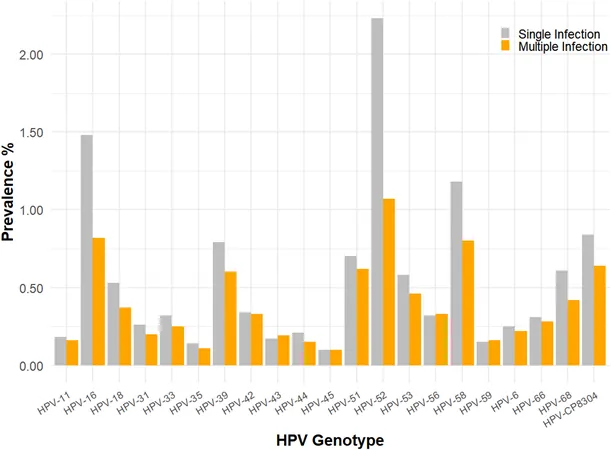
Startling HPV Trends Uncovered in Guangzhou: A Deep Dive into Over 76,000 Cases
2025-06-03
Author: Li
Major HPV Findings from Guangzhou's Extensive Study
A groundbreaking analysis of over 76,000 women in Guangzhou reveals a startling Human Papillomavirus (HPV) prevalence of 15.21%. Out of this, a significant number—11,687 women—tested positive for HPV, uncovering critical insights into the patterns of infection that could reshape public health strategies.
Inside the Infection Rates: What the Numbers Say
The report highlights that high-risk HPV (HR-HPV) infections accounted for 12.46% while low-risk HPV (LR-HPV) infections made up 4.36%. The study distinguishes between single-type infections (11.70%) and more complex multiple-type infections (3.50%), painting a vivid picture of how these viruses manifest in different women.
Concerning Trends in Multiple Infections
Interestingly, double infections were the most common in the multiple-type category, followed by triple and quadruple infections. One individual presented an extreme case of eight concurrent HPV types. Such complexities are a significant concern, as they often correlate with more severe health issues.
Age Matters: Who's Affected Most?
The mean age of HPV-positive women was 37.34 years, with those aged 30 being the most frequently infected. Alarmingly, 23.09% of HR-HPV-positive women were over 45, a demographic often overlooked in vaccination strategies.
A Longitudinal Look: Stability and Shifts from 2013 to 2021
Over the study period from 2013 to 2021, the overall HPV prevalence remained stable. However, a severe decline in certain genotypes, like HPV-16 and HPV-18, suggests that vaccination efforts introduced in 2016 may be impacting infection rates. Meanwhile, others, like HPV-35 and HPV-39, showed a significant rise.
Regional Variations: A Snapshot of China's HPV Landscape
This study's prevalence of 15.21% is lower compared to cities like Beijing (20.1%) but higher than regions like Tibet (8.16%). Variations across different regions can be attributed to differences in sexual behaviors, socioeconomic status, and healthcare accessibility.
The Imperative for Vaccination and Screening Programs
The findings underscore the pressing need for targeted vaccination programs to protect younger populations and robust cervical cancer screening initiatives for older demographics. With most infections occurring among sexually active women between 23 and 49, timely interventions are crucial.
Addressing Gaps: Call for Further Research
While this extensive study sheds invaluable light on HPV trends, the researchers caution that it has some limitations. There’s a pressing need for future studies to integrate vaccination histories and delve into the relationship between specific HPV genotypes and cervical lesions.
Conclusion: A Wake-Up Call for Women's Health in China and Beyond
The striking findings from Guangzhou emphasize the importance of continuous monitoring of HPV genotypes. As we stand on the brink of potentially life-saving vaccine deployments and updated cervical cancer strategies, the urgency to act on these insights has never been greater.

 Brasil (PT)
Brasil (PT)
 Canada (EN)
Canada (EN)
 Chile (ES)
Chile (ES)
 Česko (CS)
Česko (CS)
 대한민국 (KO)
대한민국 (KO)
 España (ES)
España (ES)
 France (FR)
France (FR)
 Hong Kong (EN)
Hong Kong (EN)
 Italia (IT)
Italia (IT)
 日本 (JA)
日本 (JA)
 Magyarország (HU)
Magyarország (HU)
 Norge (NO)
Norge (NO)
 Polska (PL)
Polska (PL)
 Schweiz (DE)
Schweiz (DE)
 Singapore (EN)
Singapore (EN)
 Sverige (SV)
Sverige (SV)
 Suomi (FI)
Suomi (FI)
 Türkiye (TR)
Türkiye (TR)
 الإمارات العربية المتحدة (AR)
الإمارات العربية المتحدة (AR)